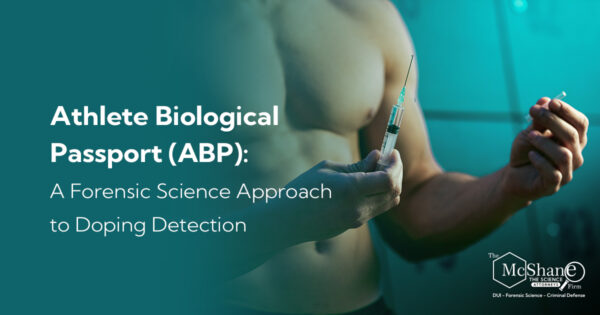Introduction:
The Athlete Biological Passport (ABP) is a groundbreaking, longitudinal monitoring program designed to combat doping in sports by tracking selected biological variables in athletes’ blood and urine samples over time. This innovative approach relies on forensic science techniques to analyze these variables, enabling the detection of abnormal changes that may indicate doping. In this blog post, we will explore the technical aspects of the ABP and how it has revolutionized the fight against doping in sports.

Athlete Biological Passport: A Brief Overview
The ABP is a personalized, electronic record of an athlete’s biological measurements, which are collected through blood and urine samples at regular intervals. The passport includes two modules: the hematological module, which focuses on blood parameters related to erythropoiesis (red blood cell production), and the steroidal module, which tracks urinary steroid profiles. The primary goal of the ABP is to identify unusual changes in an athlete’s biological parameters, which may suggest the use of banned substances or methods.
Forensic Science Techniques in the ABP
Several advanced forensic science techniques are used to analyze the biological variables in the ABP, providing a comprehensive and sophisticated approach to doping detection. These techniques include:
-
- Hematological Module:
The hematological module monitors blood parameters, such as hemoglobin concentration, hematocrit, red blood cell count, reticulocyte count, and mean corpuscular volume. The analysis of these parameters can reveal abnormal fluctuations, which may indicate the use of blood doping methods, such as erythropoietin (EPO) administration or blood transfusions.
Flow Cytometry: Flow cytometry is used to accurately measure the various blood parameters in the hematological module. This technique involves the use of fluorescently labeled antibodies that bind to specific cellular markers, allowing for the precise quantification and characterization of red blood cells and reticulocytes.
Indirect biomarkers: The ABP also examines indirect biomarkers, such as the soluble transferrin receptor (sTfR) and the percentage of immature reticulocytes (IRF). These markers can provide additional information about erythropoiesis and help identify potential blood doping practices.
-
- Steroidal Module:
The steroidal module focuses on the urinary steroid profile, which includes the concentrations of testosterone, epitestosterone, androsterone, etiocholanolone, 5α-androstane-3α,17β-diol, and 5β-androstane-3α,17β-diol. These steroid concentrations are used to calculate ratios and concentrations, such as the testosterone to epitestosterone (T/E) ratio, which can indicate the potential use of anabolic steroids or other prohibited substances.
-
- Gas Chromatography-Mass Spectrometry (GC-MS) and Liquid Chromatography-Mass Spectrometry (LC-MS): These analytical techniques are employed to accurately measure the urinary concentrations of the steroids in the steroidal module. GC-MS and LC-MS allow for the separation, identification, and quantification of trace levels of steroids in complex biological samples.
- Carbon Isotope Ratio Mass Spectrometry (CIR-MS): In cases where the T/E ratio is suspicious, CIR-MS can be used to determine the carbon isotope ratios of testosterone and its metabolites. This technique can differentiate between endogenous (naturally produced) and synthetic (externally administered) steroids based on differences in their carbon isotope ratios.
Cases of ABP only prosecution
There have been cases where athletes have been prosecuted for doping based solely on their Athlete Biological Passport (ABP) results, even in the absence of direct positive tests from analytical chemistry techniques. The ABP approach, which relies on the longitudinal monitoring of an athlete’s biological parameters, has been successful in detecting abnormal patterns suggestive of doping practices.
A notable example is the case of the Italian cyclist Franco Pellizotti. In 2010, the Union Cycliste Internationale (UCI) suspended Pellizotti based on irregularities in his ABP, despite the absence of a positive test result from traditional analytical chemistry techniques. The Court of Arbitration for Sport (CAS) upheld his two-year suspension, emphasizing that the ABP was a valid and reliable method for detecting blood doping.
Similarly, in 2011, another Italian cyclist, Pietro Caucchioli, was suspended for two years based on abnormalities detected in his ABP. Again, the CAS upheld the suspension, reinforcing the legitimacy of the ABP as a means of identifying potential doping practices.
These cases demonstrate that the ABP has been successful in detecting potential doping practices even when traditional analytical chemistry techniques have not provided direct evidence. The ABP’s longitudinal approach and its ability to identify abnormal biological patterns have proven to be a powerful tool in the fight against doping in sports.
Conclusion:
ABP has promise to effectively detect abnormal changes that may suggest the use of banned substances or methods. This innovative strategy not only partially deters athletes from engaging in doping practices but also helps protect the integrity and fairness of sports competitions.
As the field of forensic science continues to evolve, new techniques and technologies will undoubtedly be incorporated into the Athlete Biological Passport program, further improving its ability to detect and deter doping. For example, omics technologies, such as genomics, proteomics, and metabolomics, hold great promise for expanding the scope of the ABP and identifying novel biomarkers indicative of doping.
In summary, the Athlete Biological Passport represents a significant advancement in the battle against doping in sports. By leveraging cutting-edge forensic science techniques and continuously monitoring athletes’ biological parameters, the ABP serves as a powerful tool to ensure clean and fair competition for all athletes. With ongoing research and technological advancements, the effectiveness and scope of the ABP will only continue to grow, solidifying its role as an indispensable tool in the fight against doping in sports.


